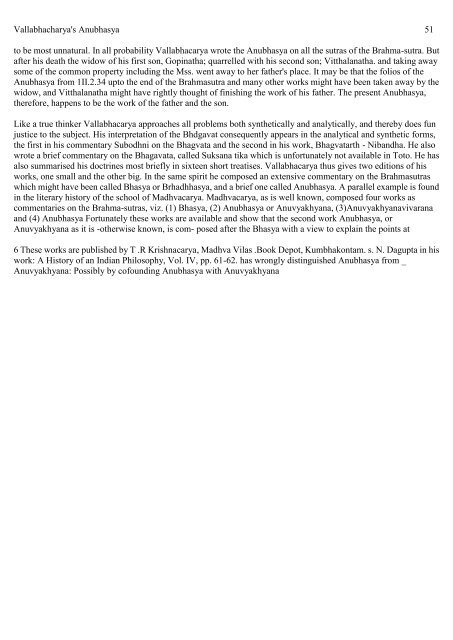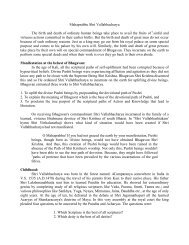Sri Vallabhacharya - Pushti Darshan
Sri Vallabhacharya - Pushti Darshan
Sri Vallabhacharya - Pushti Darshan
Create successful ePaper yourself
Turn your PDF publications into a flip-book with our unique Google optimized e-Paper software.
<strong>Vallabhacharya</strong>'s Anubhasya 51<br />
to be most unnatural. In all probability Vallabhacarya wrote the Anubhasya on all the sutras of the Brahma-sutra. But<br />
after his death the widow of his first son, Gopinatha; quarrelled with his second son; Vitthalanatha. and taking away<br />
some of the common property including the Mss. went away to her father's place. It may be that the folios of the<br />
Anubhasya from 1II.2.34 upto the end of the Brahmasutra and many other works might have been taken away by the<br />
widow, and Vitthalanatha might have rightly thought of finishing the work of his father. The present Anubhasya,<br />
therefore, happens to be the work of the father and the son.<br />
Like a true thinker Vallabhacarya approaches all problems both synthetically and analytically, and thereby does fun<br />
justice to the subject. His interpretation of the Bhdgavat consequently appears in the analytical and synthetic forms,<br />
the first in his commentary Subodhni on the Bhagvata and the second in his work, Bhagvatarth - Nibandha. He also<br />
wrote a brief commentary on the Bhagavata, called Suksana tika which is unfortunately not available in Toto. He has<br />
also summarised his doctrines most briefly in sixteen short treatises. Vallabhacarya thus gives two editions of his<br />
works, one small and the other big. In the same spirit he composed an extensive commentary on the Brahmasutras<br />
which might have been called Bhasya or Brhadhhasya, and a brief one called Anubhasya. A parallel example is found<br />
in the literary history of the school of Madhvacarya. Madhvacarya, as is well known, composed four works as<br />
commentaries on the Brahma-sutras, viz. (1) Bhasya, (2) Anubhasya or Anuvyakhyana, (3)Anuvyakhyanavivarana<br />
and (4) Anubhasya Fortunately these works are available and show that the second work Anubhasya, or<br />
Anuvyakhyana as it is -otherwise known, is com- posed after the Bhasya with a view to explain the points at<br />
6 These works are published by T .R Krishnacarya, Madhva Vilas .Book Depot, Kumbhakontam. s. N. Dagupta in his<br />
work: A History of an Indian Philosophy, Vol. IV, pp. 61-62. has wrongly distinguished Anubhasya from _<br />
Anuvyakhyana: Possibly by cofounding Anubhasya with Anuvyakhyana



